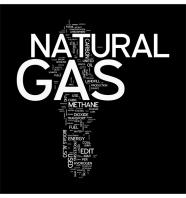Truckers May Soon be Stepping on the LNG
GE and Clean Energy Fuels Partner to Build out Infrastructure

Truckers will soon be stepping on the gas, or the
liquefied natural gas (LNG,) that is. General
Electric and Clean Energy Fuels Corp. are partnering
to build a series of fueling stations across the
country -- a phenomenon that they say is demanded by
the automotive manufacturers.
The selling point is that natural gas used for
transportation cost 25 percent less than petroleum.
It’s also cleaner. And when the two factors are
combined, it is potentially a better deal for
truckers that would use the LNG. But the kicker is
that converting or building those 18-wheeler trucks
that run on such specialized engines is an expensive
proposition.
The LNG equipment market is potentially huge, or as
much as $1 billion in five years, says GE. To start
things out, Clean Energy says that it bought a few
hundred trucks. “Today, every original equipment
manufacturer has announced a natural gas product,”
says Andrew Littlefair, chief executive of the
Seal Beach, Calif.-based company, in response to
this reporter’s question during a conference call
today.
Altogether, Littlefair says that buying LNG would
cost about $1.50 less per gallon than traditional
gasoline. He adds that the company now has about
75 current fueling stations and that it is in
the process of doubling that.
Enter GE. Clean Energy is buying two LNG plants
from GE Oil and Gas. GE is also financing the deal,
providing about $200 million. The facilities, which
will super-cool the natural gas so that it can be
transported to the filling stations, are expected to
be operational by 2015. They will supply 250,000
gallons per day, or enough to fill 28,000 trucks,
says GE.
“It is truly a partnership,” says Mike Hosford,
general manager of unconventional resources at GE
Oil & Gas, during the conference call. In other
words, Clean Energy is building out the
infrastructure and GE is supplying the expertise to
convert the natural gas to LNG, while financing it.
“We’ve seen huge increases in (alternatively-fueled)
vehicles,” says Hosford. “It comes back to emissions
and to economics. It is so compelling.”
Momentum Slow
Both Clean Energy and GE say that the existing
market provides a gauge. They point to Fed Ex and to
UPS, which are using increasing amounts of
compressed natural gas (CNG). They also note that
Waste Management has announced that it will use CNG
for 80 percent of its new trucks that haul trash.
Once those entities start saving money, the partners
argue that their competition would have no choice
but to make similar business choices.
While CNG is primarily used in cars, buses and
smaller trucks, the LNG that is getting rolled out
at Clean Energy’s fueling stations is targeted at
long-haul, heavy-duty trucks, which will have the
advantage of longer driving ranges while not
impacting tractor weight and incremental costs, says
the company’s release. In 2013, four major
manufacturers will introduce a 12-liter LNG engine,
which is the optimum size for heavy-duty 18-wheeler
trucks.
“As the long-haul trucking industry begins its
transition to natural gas, it will be critical to
have a reliable supply of LNG,” says Littlefair. He
says that Clean Energy has signed non-disclosure
agreements to expand the infrastructure if the
trucks are produced.
Cost, of course, is the primary obstacle. Here, the
American Trucking Association is working with
U.S. lawmakers to help subsidize this conversion.
President Obama is in favor of using government’s
levers to help make the transition to cleaner
burning fuels but the fiscal hawks say that
taxpayers cannot afford it.
What else may block the road? Manufacturers and
chemical makers are concerned that an increased
demand for natural gas would drive up their energy
costs. That would make them less competitive. The
oil companies, meanwhile, also have a financial
stake. While some are accusing them of impeding
progress, Big Oil says that it can supply both oil
and natural gas.
“I’m not going get out my crystal ball and say when
this will move into the passenger vehicle market
will occur,” says Littlefair. “It starts with
fleets. The same thing will happen in trucking. But
it will take a while to filter through the system.
It will be very manageable. So, you can build both
power plants and supply transport without
significantly affecting prices.”
The tea leaves would tend to indicate that the
transportation sector will increasingly fill up with
both CNG and LNG. But the momentum is slow and it is
not likely to gather steam until the existing buses
and trucks become outdated and need to be replaced.
EnergyBiz Insider has been awarded the Gold for
Original Web Commentary presented by the American
Society of Business Press Editors. The column is
also the Winner of the 2011 Online Column category
awarded by Media Industry News, MIN. Ken Silverstein
has been honored as one of MIN’s Most Intriguing
People in Media.
Twitter: @Ken_Silverstein
energybizinsider@energycentral.com
Copyright © 1996-2012 by CyberTech, Inc. All rights reserved.
To subscribe or visit go to: http://www.energycentral.com
To subscribe or visit go to: http://www.energybiz.com